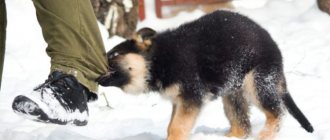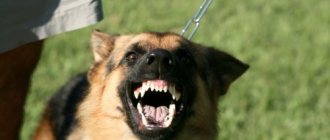The realities of the modern world teach that you cannot trust anyone’s word if there are no documents confirming these very words. If a dog breeder decides to have a purebred pet, then the first thing you need to worry about is the attached documents of the RKF - the only branch of the internationally recognized canine federation in Russia. It is these papers that will prove the purebred of the animal.
RKF documents are an important part of the deal when buying a purebred puppy
What is RKF in dogs?
If a dog breeder has the idea of getting a purebred puppy, it’s time to find out what the RKF documents for the dog are.
Determination of purebred dogs is carried out by specialized organizations, some of which are certified. The largest is the FCI or FCI; it is recognized not only throughout Russia, but also beyond its borders. The official representative in the Russian Federation is RKF - Russian Cynological Federation.
When there is a dialogue with the aim of purchasing a kitten, the seller is obliged to provide paper confirming the purebred of the dog. All documents without the RKF seal are invalid. The buyer needs to ask direct questions; there is no need to doubt and be afraid of giving the impression of someone who does not know what they are talking about. A breeder who breeds in good faith will provide documents in a timely manner and prove their authenticity.
Attention! Each country has its own specialized institutions. If someone tries to sell a puppy from a kennel with a document that is supposedly recognized in another country, you can be sure that it is a fake.
What do documents for a puppy look like?
But here some difficulties begin. The fact is that there are several cynological organizations that keep records of the number of purebred dogs in the territory of the former CIS. Which canine organization is better is not the subject of today's discussion. Let's just say that the most widespread and largest in the world is the FCI (FCI), its full members in Russia are the RKF (Russian Cynological Federation), Ukraine - KSU (Cynological Union of Ukraine), Belarus - BKO (Belarusian Cynological Association), Kazakhstan — SKK (Union of Cynologists of Kazakhstan).
| FCI (Fédération Cynologique Internationale) FCI - (International Canine Organization) | |||
| Russia | RKF | Russian Cynological Federation | rkf.org.ru |
| Ukraine | KSU | Cynological Union of Ukraine | uku.com.ua |
| Belarus | BKO | Belarusian Cynological Association | bcu-upo.org |
| Kazakhstan | SKK | Union of Cynologists of Kazakhstan | uck-kz.org |
Below are examples of what a puppy's certificate issued by these organizations should look like (click to enlarge):
| RKF puppy metrics | KSU puppy metrics |
Attention! If you buy a puppy, for example, in Ukraine with a puppy certificate issued by the RKF, then in 99% of cases it is a fake and fraud. Puppies outside of their country of birth are sold with export pedigrees and not with puppy metrics.
What are documents for a dog, what should they be and why are they needed?
Documents confirming purebredness include the following papers:
- puppy card;
- pet examination report;
- the act of mating breeding dogs;
- veterinary passport of the pet;
- a certificate stating that the puppy comes from a family of purebred dogs; other names are metrics, puppy card or dog passport.
Additional Information! If a puppy has not reached six months of age, it cannot have a pedigree.
If a breeder claims otherwise and tries to sell a dog under this age, we can safely conclude that he is lying.
Why do ordinary dog breeders need a pedigree?
Pedigree puppies with documents are more expensive than others.
As mentioned earlier, only documents can confirm what people say and prove that they are telling the truth. That is why any dog breeder who wants to prove the true pure breed of their pet must provide documentation. If it is not there, then there can be no confidence in the words. Documents will help protect the honor of not only the pet, but also the owner.
In addition, any buyer of a dog that is passed off as a purebred will be interested in the documents before receiving it. After all, the fact is that such a pet will have a higher price. In order not to create problems and not to be deceived, he will take care in advance and make sure that certified documentation is available.
We must also not forget that only purebred dogs can participate in exhibitions and receive awards. Without supporting documents, the jury will not even look at the animal.
Reasons for missing documents
The simplest thing is simple deception. That is, the breeder sells simple puppies, but wants to add a price to them. In this case, it is better to immediately refuse to deal with him and look for more decent people. But what if they really show dogs with pedigrees that are the mother and father of the puppies, but they start telling that the puppy documents are not ready yet (they didn’t do it, didn’t have time, didn’t pay for it)?
There can be many reasons here too. It’s not a fact that they show you real parents. Even if this is the case, then perhaps one of them was disqualified, and they continue to knit him. In this case, you should know that the basis for issuing documents to puppies is registration of mating in the club. That is, the owner of the bitch contacts the administrator, informing him that his dog is in heat. Club specialists check her admission to breeding, select the best male and arrange mating. Usually this happens directly in the club, where the fact is documented. That’s it, now the question of how to make a pedigree for a dog can be solved extremely easily. After the babies are born, a specialist from the club comes, examines the litter and issues metrics, which the breeder will hand over to the owners along with the puppies. Now contact them at the specified address and register in the club.
Why is the puppy first given a metric and not a full pedigree?
Among the documents for a dog, there is a metric that records the name of the pet, the date of its birth, the names and pedigree of the parents, all the numbers of the terminals and the necessary microchips. The club, certified by the RKF, issues this document immediately after birth to all puppies born to the dog.
It is important to understand that at the time the puppies are born, the parents must have their own pedigree so that this fact is recorded in the metric. Another name for this document is a puppy card.
Before the age of six months, it is difficult to check whether a puppy matches the purity of the breed and to determine disqualifying defects. Therefore, first a metric is issued, and only then a full pedigree, in which the class of the dog is recorded.
Document confirming the origin of the puppy
The paper, which is popularly called “puppy card” by dog lovers, is officially called a puppy metric or puppy card. It states the breed, nickname, date of birth, gender, brand or chip, parents' nicknames and their pedigree numbers (.), as well as the names and addresses of the breeder (owner) of the bitch and the future owner of the puppy.
The puppy's metric is divided into two parts by a cutting line. When exchanging it for a pedigree, the upper half is given to a canine organization, and the lower spine remains with the owner until the pedigree is ready.
At what age do you need to change puppy metrics to pedigree?
After some time, it will be possible to exchange this document for an official pedigree. Registration can begin from the moment the puppy reaches six months of age. And the process must be completed before one year and three months have passed.
After the puppy receives the document, he will officially be able to:
- Participate in exhibitions from the age of fifteen months.
- Take part in competitions.
- The owner can use him in breeding.
If the veterinary passport for dogs is lost
In case of unexpected loss of your passport due to certain circumstances, you can easily restore it. To obtain this opportunity, the owner should contact the organization that last vaccinated the dog. The clinic provides all the necessary information about the vaccination procedure, as well as where it was carried out.
Visitor requests are recorded in a special journal, so if necessary, you can create an archive of all patient requests. This measure makes it possible to control patient visits, and also allows you to store data on various procedures for a long time.
In addition, all institutions are required to keep such records, since today the legislature obliges veterinary clinics to submit a report on their activities for a certain period. Such documents are stored for ten years.
In the modern world, the owners of their pets prefer the microchipping system and for good reason, because it is this function that allows you to save important information and information about the furry patient, in addition, if your passport is lost, it can be quickly restored.
When issuing documents and certificates in clinics that indicate permission to transport an animal and participate in various exhibitions, carefully check all the details and information provided. Be sure to pay attention to this process, since very often owners miss any important components in the issued document.
What is a zero or registered pedigree?
If the pet does not have information about its ancestors, a zero pedigree is issued instead.
The list of documents may also contain a zero document if the owner does not know what the dog’s pedigree looks like. A similar paper is drawn up even if there is no information about the puppy’s parents, if there is no certificate.
Taking into account all the exterior data that is recorded at dog shows, the document is filled out. The difference lies in the fact that these pets cannot take part in breeding. The thing is that information about the ancestors, up to the seventh generation, was not given out.
What documents confirm the dog's breed?
The only document confirming the breed and origin of the dog is the pedigree (if we are talking about a puppy, then the puppy metric, also known as the puppy card). Remember once and for all: if your dog does not have a pedigree, then it cannot be considered a purebred. It is in the dog’s pedigree that the ancestors up to the 3rd or 4th generation are recorded; it is this that confirms that if you buy, for example, a Chiuhahua puppy, then his grandfather was definitely not a Russian Toy!
You have the right to be offended and prove that you have a purebred dog, but if the dog does not have supporting documents, it is just a dog that looks like a representative of the breed.
Below are examples of what a dog's pedigree looks like (click to enlarge):
So, we figured out what the documents for a dog look like. Now let's figure out how they are made.
How to get a pedigree
SKOR is another canine organization in Russia.
After the owner has found out what RKF is in dogs, all that remains is to fill out a package of papers. All questions about how to obtain documents for a dog can be clarified with official representatives in Russia. As soon as you find out the coordinates of the nearest branch, you can visit them or contact them by phone or Internet.
The entire process will take Muscovites a little less than a month, while nonresidents will have to wait about three months for it to be ready. All you need is a pet card, all the information in which will help you draw up a pedigree. You will also need a litter inspection certificate and a breeding card of the puppy's parent. RKF representatives will issue document forms upon registration.
There is also an option to do this through the club in which the pet is registered, you just need to write an application. If this is an official representative of the RKF, he will easily organize the process without making the life of the owner difficult. Once the pedigree is ready, the dog breeder will be able to receive an official document.
Attention! Many people are interested in the question of what SCOR documents for a dog are - these are papers from another domestic canine organization. The Union of the Russian Canine Association is recognized only in the CIS, which blocks the owner’s path to exhibitions on a European scale.
Topic details
Veterinary passport
This is a document similar to a medical record. It will list all the vaccines and parasite treatments given to the dog.
The first pages of the veterinary passport will indicate the dog's name, its breed, as well as information about its owner. There should also be a sticker with the animal's chip number, if it has one.
NOTE! This document is issued for any dog upon its first visit to a veterinary hospital.
Therefore, you should not mistakenly think that it is evidence of the pet’s thoroughbred. A veterinary passport is issued by a veterinarian simply from the words of the owners.
The purpose of this document is so that the owner can always prove to other people about the safety of his pet. And this is precisely confirmed by the records made in it about vaccinations. Vaccinations must be against infections, and a rabies vaccination is also given every year. Without them, a dog, even of impeccable origin, will not be able to participate in exhibitions, competitions, will not be allowed to breed and will not be able to travel outside the country.
Document on the origin of the dog
This is a paper, also called a dog passport or metric, which indicates the breed of the dog, its name, gender, date of birth, brand or chip number. In addition to information about the puppy itself, this document must contain information about the puppy’s mother and father (their names and pedigree numbers), as well as information about the owner of the puppy’s mother and the future owner of the puppy.
Using a cutting line, this document is divided into two parts, one of which is transferred to the canine organization. There it is exchanged for a pedigree, and the second remains with the owner for the duration of the exchange.
Appearance of dog documents
A puppy's certificate may look different depending on which cynological organization issued it. On the Internet you can find examples of what documents for a dog look like.
Documents proving the dog's pedigree.
A dog's pedigree is confirmed only by its pedigree. In the case of a dog under six months old, this document is a metric. A dog without a pedigree cannot be considered a purebred dog. This document indicates the details of her ancestors up to the third or even fourth generation. Your dog may be a purebred dog, but without documents confirming this fact you will not be able to prove it to anyone.
How to get documents for a dog
If you buy a good puppy from a trusted breeder, he must provide you with a certificate for it along with the dog. In this case, after the puppy is six months old, you must contact a canine organization yourself. There they will exchange your metric for your pedigree. It does not matter which specific department issued the primary document. The best option would be to find the website of a canine organization on the Internet and find the branch closest to you there. It will be more convenient for you to go there.
How to make documents for a dog without a pedigree
If you buy a dog without documents, but are confident in its purebred, you can try to register a pedigree for it. To do this, you need to go to the rings that are available at exhibitions. They confirm the breed. You need to sign up in advance so that your pet can be assessed by three different judges. Then, with three descriptions of your dog, you will need to go to a canine organization, where you should be given a so-called registered pedigree (zero). Of course, it will not indicate your pet's ancestors.
REFERENCE! Not long ago, the FCI stopped allowing dogs with registered pedigrees to be allowed for breeding. Therefore, the owner of such a dog will only be able to participate with it in exhibitions and competitions.
Registration of a pedigree without metrics
In the event that before receiving the dog and after that the owner did not take care of issuing the metric, certain difficulties may arise with the registration of the pedigree. But there is no reason to panic if the puppy has a mark on its ear, which confirms the dog’s purebredness.
Important! Another document that can help replace a metric is an expert assessment. If available, the owner will be issued a registration document.
As soon as all the documents are provided and the puppy is six months old, all information about the litter will be in the RKF, the registration process will begin and will not distract the owner from necessary matters.
Document preparation
If a puppy with a pedigree is purchased from a breeder, in a club, or from owners who conscientiously breed, then immediately with the baby you are required to issue him a passport, which will contain all the notes about his vaccinations and so on. By the way, the first vaccination should be done at the age of two months, and puppies are usually given away from the third month. The animal's passport contains all the notes about vaccinations and all veterinarian manipulations, so if you take a puppy more than two months old, it should already have at least one vaccination.
How to restore a pedigree if it has been lost
If the owner has lost his pedigree, there are several options for how to restore it. To do this, the owner must:
- ask the breeder for a copy of the document;
- the breeder independently contacts the FCI, where a copy of the document will be made.
In the event that information about the breeder is unknown, for restoration you will need a brand or a pet card, which is issued at the exhibition. As soon as the RKF stamp number is reported, the organization’s employees will describe in detail the algorithm of actions.
International veterinary passport
A veterinary passport is a small brochure of international standard, which records the vaccinations and necessary procedures throughout the pet’s life in order to protect against parasites. On the first page you can find key information about the puppy.
Additional Information! A special chip is also attached to the first page. The pet's number is stored on it.
What is recorded in the veterinary passport:
- what vaccinations and vaccinations were administered to the pet’s body;
- what treatment measures were taken, whether the absence of dysplasia was checked;
- if the animal was microchipped, what is the chip number;
- whether the pet has a mark, which is very important for traveling abroad.
They begin processing the passport from the moment the dog was first vaccinated. All details related to appearance and origin are included in the document. These are mostly depicted as stickers.
The main thing you need to know is that any clinic has the right to issue this passport. It in no way confirms the purebred of the pet. The key purpose of creating a passport is to document the fact that the pet is not dangerous to others and that it itself is not in danger of illness or danger. If the owner does not obtain this passport in a timely manner, he will not have the opportunity to travel abroad.
List of documents for taking a dog abroad
In order to take your pet abroad, you need to provide a list of documents. The key paper is certificate No. 1, issued by the State Veterinary Service.
This document is issued if the dog has:
- Veterinary passport.
- The owner has a dog breeder's passport.
- The pet has a chip, the owner has a certificate with him confirming this fact.
- The dog is provided for examination by the service.
In addition to the first certificate, you need to have an international pet passport and a certificate issued in Form 5a. The latter is needed to visit Europe. You need to worry about documents and their execution at least three days before departure or trip.
Note! Some customs officers may require another certificate. This is a document confirming that your pet does not have rabies.
What document is required to participate in international exhibitions?
In order for your pet to be able to take part in an international exhibition, you must first find the first competition. As soon as the owner finds it, you can start processing the documents.
What you will need:
- microchipping a dog;
- make a metric;
- for adult pets - complete a pedigree;
- certificate according to sample No. 1;
- veterinary passport.
It would be advisable to make copies of documents, which you can also take with you to the exhibition
Pedigree
Pedigree is the most important document of a purebred dog, the registration of which is handled by the RKF office, located in Moscow at st. Gostinichnaya, 9. Recently, the Federation has been cooperating only with legal entities, therefore, in order to obtain a pedigree, you need to apply with a puppy passport to any kennel club or to a breeder that provides similar services. They will send documents for registration of pedigree to the Moscow office of the Russian Federation, but for such services a separate fee is charged, which is set by each performer independently.
At RKF you can obtain one of the following document options:
- internal pedigree – used in Russia and filled out in Russian;
- RKF Registration Certificate (Pedigree) – issued for dogs that take part in international exhibitions. It is filled out in Latin characters, so the owner must indicate the dog’s name in English transcription when submitting documents.
Dog breeders recommend registering a pedigree after the pet is 6 months old. In this case, the breeder will already have time to submit and register information about the litter to which the puppy belongs to the RKF, so there will be no need to wait additionally. The deadline for registering a pedigree is 15 months.
The cost of registering a pedigree for a dog in the RKF depends on the urgency of registration and other nuances:
- 600 rub. for citizens of the Russian Federation within 15 days – 600 rubles. and 2 times more expensive if processed within 2 hours.
- 1500 rub. for foreigners and animals registered abroad within 15 days and 2 times more expensive if processed within 2 hours.
Additionally, you need to pay the cost of intermediary services of the kennel club and, if necessary, postage.
How to distinguish fake from real papers
Some owners decide to act in bad faith and sell a fake purebred dog to another person. To avoid falling for scammers, it is important to remember the following:
- On the metric, it is important to check the authenticity of all RKF seals. Each document is recorded with a specific set of numbers, which RKF stores in its database. To make sure, you can contact them.
- All RKF documents will be laminated. If the seller claims that this is not necessary or begins to come up with excuses, you should think about the veracity of his words. A sample of documents can also be found on the official website of the organization. In case of discrepancy with what the seller provides, the purchase of this dog should also be refused.
- It is important to study the veterinary passport, and if you don’t have it, ask for one.
- It is advisable not to purchase purebred pets from someone else if the owner wants to start making money at exhibitions. If there is no such goal, then even a simple mongrel, not a husky or a puppy of another dog breed, can become a good companion and a true friend.
It is important to remember that RKF documents are an important component when purchasing a purebred dog. All papers confirming the purebred of the pet are a guarantee of participation in exhibitions and the absence of problems when breeding the breed. When purchasing a dog, the future owner must remember this, otherwise he may find himself in an awkward situation when he is deceived by scammers.









